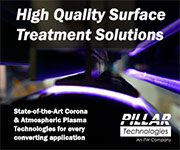Atmospheric Plasma: The New Functional Treatment for Films
- Published: February 01, 2001, By A. Yializis, Sigma Technologies Intl. and David A. Markgraf, Enercon Industries
Email the author(s) at markgraf@enerconmail.com
Following is an expanded summary of a complete paper available on the TAPPI web site at tappi.org. On the page, click "the PLACE" in the section designated "Journals."
Application: Specialty films that require stringent surface morphology specifications, specific surface modification, precise surface coating, or tightly controlled electrical characteristics will benefit from atmospheric plasma treatment.
Corona discharge and flame treatment processes are currently the predominant techniques used for treating the surface of polymer films and other substrates such as foils, papers, etc. This treatment increases the surface energy of the substrates that in turn improves the wettability, printability, and adhesion on these surfaces. Corona discharges can produce locally concentrated discharges known as streamers. These streamers cause some nonuniformity in the treatment of the film surfaces, and the concentrated energy of the streamers can microscopically damage the film surface. In addition, corona treatment can produce backside treatment that is undesirable in many applications. Flame treatment also has limitations for oxidative surface modification, difficulty in control, and a possibility of excessive thermal loads.
Plasma treatment is an effective method of treating surfaces to increase surface energy. Plasma produces uniform surface treatment without any backside treatment of a substrate. A novel atmospheric plasma treatment (APT) process offers unique advantages over existing technologies of surface treatment. The APT apparatus does not require any vacuum systems, produces a high density plasma, and provides treatment of various substrates at low temperatures while operating open to the atmosphere. This newly developed system also has the flexibility for use as a reduced ozone corona system and a controlled gas chemistry corona system with "chemical corona."
Plasma Treatment
Plasma is an ionized form of gas created using a controlled level of AC or DC power and an ionizing gas medium. The plasma— commonly called the fourth state of matter—that results is an ensemble of randomly moving charged atomic particles with a sufficient particle density to remain electrically neutral on average. Plasmas have use in very diverse applications. Plasma processes fall into two classes—low density and high density.
ATP Process
The ATP process is useful for treating and functionalizing polymer films. It has unique advantages over the presently used technologies of corona and flame treatment. The system allows creation of a uniform and homogeneous high density plasma at atmospheric pressure and low temperatures using a broad range of inert and reactive gases. The APT process treats and functionalizes polymer films in the same way as the vacuum plasma treatment process. APT production equipment testing has been successful for treatment of various polymer films including oriented polypropylene (OPP), polyethylene (PE), polyethylene terephthalate (PET), and polytetraflluoroethylene (PTFE). The surface energies of the treated films increased substantially without any backside treatment. This enhanced the wettability, printability, and adhesion properties of the films.
In the APT process, plasma is generated at atmospheric pressure and low temperatures using an ac power source, a proprietary designed electrode, a dielectric layer between the electrodes, and an appropriate gas mixture as the plasma medium.
Attributes of ATP
The atmospheric plasma system is useful for treating and modifying the surface properties of organic and inorganic materials. The plasma system has use for a wide variety of applications including treatment of polymer films, paper, wood, and foils; plastma grafting and plasma polymerication; ashing various materials in the microelectronics industry; barrier layer deposition for the packaging industry; and sterilizing biologically contaminated materials. For polymer films, the technique offers the following advantages:
-
Uniform treatment
-
Improved surface energy with concomitant improved wettability, printability, and adhesion
-
No backside treatment.
Treatment Results on Polymer Films
OPP, PE, PET, and PTFE films were treated on two webs sized 12 in. and 20 in. The primary treatment parameters were input power, gas type, flow, and the ratio of the gas mixture. Surface tension test fluid markers and contact angle measurements determined the surface tension of the treated films. Treated films were monitored and tested to investigate the aging effect of the treatment.
For a polypropylene film with initial surface tension of approximately 30 dynes/cm, Fig. 1 shows the treatment result and aging when treated by APT using helium and different mixtures of helium and a mixture of helium and acetylene. The figure shows that the treatment level when using a mixture of 90% helium and 10% acetylene does not change with time. Using only helium gas, the treatment level decreases only slightly.
The paper shows results when using other gases with polypropylene film and when subjecting other films with various gases to the treatment. In all cases, treatment level increased over the initial level and gave good retention on aging.
Conclusions
A plasma treatment system that can operate at low temperature and at atmospheric pressure eliminates the need for any vacuum chambers or pumps. It provides the unique advantages that plasma technology has over existing technologies for surface treatment.
Surface energies of polymer films treated by the APT technique increase substantially to enhance the wettability, printability, and adhesion significantly. The system also has flexibility for operation as a reduced ozone corona system and as a corona system with controlled gas chemistry, i.e., "chemical corona."













